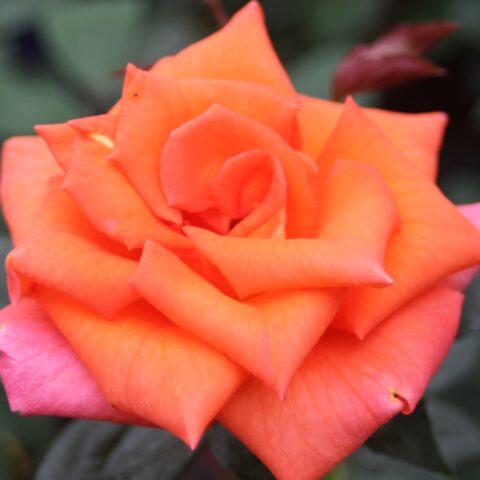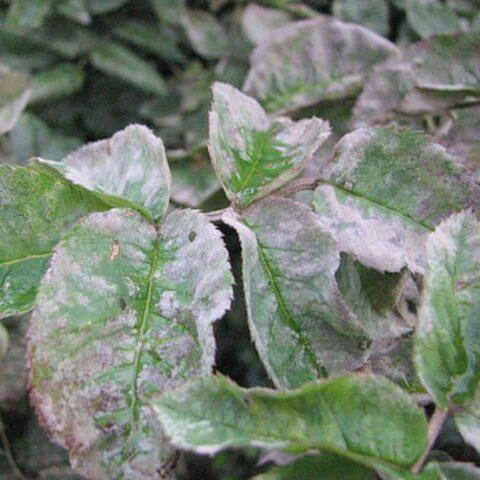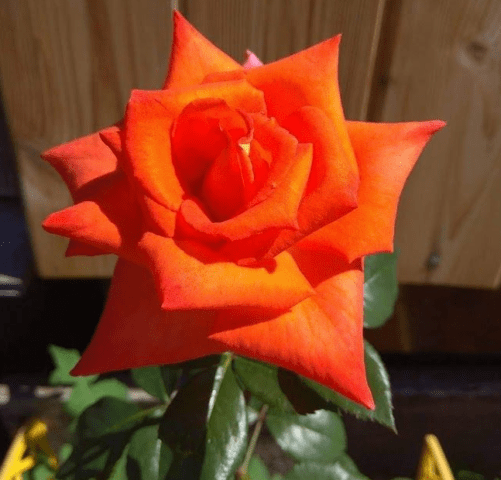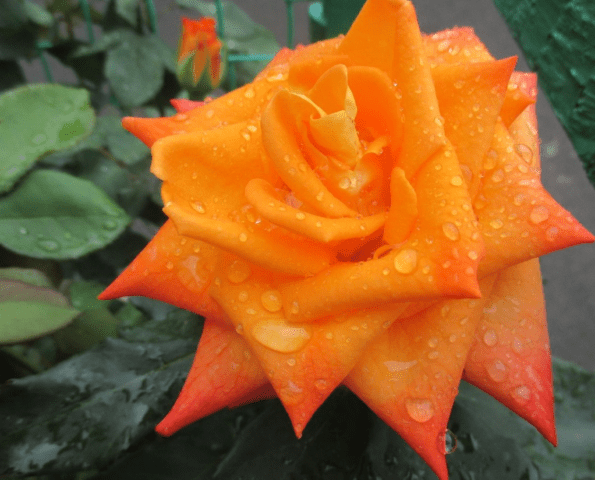Content
Rose Monica is a German variety. It produces orange flowers up to 12 cm in diameter. The inflorescences are bright, contrasting against the background of dark green glossy foliage. The bushes look attractive both in single plantings and in compositions. Flowers are used not only to decorate the landscape, but also in floristry. From roses of a sunny shade, chic bouquets are obtained, which are in demand among buyers.
Breeding history
Hybrid tea rose Monica (Rose Monica) was bred by German breeders in 1985. The variety is obtained on the basis of hybrid varieties of Horse meat and Rugosa. Almost immediately, it began to spread throughout European countries, and at the end of the 21st century it came to Russia.
Has successfully taken root in the southern regions. In other regions (middle lane, North-West, Ural, Siberia, Far East) Monica rose is also grown, but with the obligatory cover. This is important in those cases when the winter is predicted to be of little snow or the temperature drops below -30 ° C.
Description of Monica hybrid tea rose and characteristics
Rose Monica is a perennial medium-sized bush with a fairly compact crown. The culture is densely leafy, the leaves are small, ovoid, dark green in color. The leaf plates are leathery and have a glossy surface. Shoots are strong, erect.
The buds are graceful in shape, forming one on each stem. The flowers are bright orange in color, closer to the edges the petals are scarlet, a yellowish tint appears on the back. They contrast against a dark green background. Suitable for both garden decoration and cutting (long stalks, 100-120 cm and more). Flowering is profuse and long lasting.

Rose Monica produces large orange blossoms with a pleasant aroma
The main characteristics of the variety:
- medium-sized bush - 120-170 cm, in the south up to 200 cm;
- compact form, diameter up to 100 cm;
- double flowers (petals are arranged in several rows);
- large inflorescences - 10–12 cm in diameter;
- the smell is not very pronounced;
- number of buds on the stem: 1;
- poor rain resistance;
- flowering: repeated;
- resistance to powdery mildew and black spot is medium; to rust (according to reviews) weak;
- winter hardiness: zone 6 (up to -23 degrees without shelter);
- attitude to the sun: the rose Monica is photophilous.
Advantages and disadvantages of the variety
The variety is valued for its high decorative qualities. Attractive flowers enliven the garden, look good in single plantings and compositions. Also, the Monica variety is distinguished by the following advantages:
- flowers are bright, lush, large, with a pleasant aroma, used for cutting;
- the bush is compact, does not take up much space;
- suitable for growing in different regions of Russia;
- differs in unpretentiousness: care is simple;
- effectively propagates by cuttings: germination rate is close to 100%;
- flowering is repeated.
But there are several disadvantages, which are also worth paying attention to:
- in most regions (except for the south), the Monica rose needs shelter;
- buds do not open during rain;
- resistance to many diseases is average.
Reproduction methods
The culture is propagated by cuttings. The procedure can be started at the end of May or at the beginning of June, when return frosts are no longer expected.
The sequence of actions is as follows:
- From the young green shoots of the Monica rose, several cuttings 10-15 cm long are obtained (there should be 3-4 leaves).
- The lower leaves are cut off, the upper ones are shortened by half.
- Make an oblique lower and straight upper cut.
- Immerse for several hours in a solution of "Kornevin", "Heteroauxin" or other stimulant.
- Then cuttings of Monica rose are planted in a mixture of fertile soil with peat and sand (2: 1: 1).
- Grown at home or outdoors. Cover with a jar, periodically moisten and ventilate.
- In September, the sprouted cuttings are transferred to a basement, cellar or other darkened, cool place, the roots are buried in wet sand or peat, making sure that the soil does not dry out.
- In May, they are planted in a permanent place according to the instructions described below.Important! Monica rose bush, obtained by cuttings, blooms in 2-3 years.
Growing and care
In most regions of Russia, the crop is planted from late April to mid-May. In Siberia and the Urals, later dates are closer to the beginning of June (if the spring was cold). However, in the south, autumn planting is also allowed (in early September). Thanks to the warm autumn, the seedlings will have time to settle down in a new place and will endure the winter well.
The site for planting Monica roses should be well lit, not too wet, and also protected from the winds. The soil is not heavy (loose in structure) and moderately fertile. If the soil is depleted, during digging, 30-40 g of complex mineral fertilizer or 3-4 kg of humus are embedded in it for each square meter.

For lush flowering, Monica's rose needs to be fed three times per season.
The landing sequence is standard:
- The roots of the seedling are preliminarily kept in a solution of "Epin" or "Heteroauxin".
- Then, several holes are dug up to a depth of 50 cm at intervals of at least 70–80 cm.
- Pebbles, expanded clay and other small stones are poured to the bottom.
- Set the seedling, straighten the roots.
- They fall asleep with fertile soil. It can be purchased at the store or made up of turf, sand, peat, and humus (2: 1: 1: 1). In this case, the root collar must be deepened by 3-4 cm.
- When planting, it is advisable to add a complex fertilizer for roses: 100 g per bush.
- Water and mulch abundantly with sawdust, straw or other material.

The place for planting Monica's rose should be sunny, since it will not bloom in the shade
Near the center, a wooden peg is stuck, to which shoots are tied. Also, the landing can be placed next to the trellis or mesh.

When planting, the Monica rose seedling is well watered, using at least 10 liters per bush
Crop care includes several rules:
- Watering with warm water is carried out only at the root: in normal weather, weekly, in drought - 2 times. During a drought, it is advisable to sprinkle the crown in the evening hours.
- Top dressing is applied 3 times: in spring, urea (30 g per bush), during budding - an infusion of droppings or manure (diluted with water 10-15 times), during flowering - a complex fertilizer for roses.
- Weeding and loosening the soil - regularly, as needed.
- Preparation for winter (mid-October) - hilling, mulching with leaves, straw, peat. A support is installed over the Monica rose bush and covered with burlap or agrofibre. As soon as the temperature rises above +5 ° C in spring, the shelter is removed.
- Pruning - immediately after planting, you need to shorten all branches, leaving 3 buds each. The next year, in March, another radical haircut is carried out, leaving the length of the shoots 15 cm. In the fall, all wilted flower stalks are removed. Then, every spring, a sanitary haircut is carried out, and at the end of the season, the peduncles are removed again.
Pests and diseases
Rose Monica has a moderate immunity to powdery mildew and black spot. The bush can suffer from rust and various insects. Since diseases are difficult to treat, it is best to prevent them. As a preventive measure, in the fall, the soil is watered with fungicides, and in the early spring the bushes are treated with the following drugs: Topaz, Skor, Quadris, Maxim, Bordeaux liquid.

The defeat of Monica's rose with powdery mildew can be detected by bloom on the foliage.
When insects appear, they are treated with insecticides: "Decis", "Fitoverm", "Confidor", "Aktara", "Vertimek".
You can also use folk remedies: a solution of baking soda, ash and soap shavings, a decoction of marigold flowers, an infusion of onion husks and others.
Application in landscape design
In the description of the Monica rose (pictured), it is indicated that the flowers are orange in color. They look good in single plantings, especially on manicured lawns, next to a gazebo, terrace and other recreation areas.

Rose Monica is often used in a single planting
Since the bush is quite tall and compact, it can be fixed on a trellis.

Planting a rose next to the house allows you to ennoble the territory

Bushes look beautiful not only in single plantings, but also in compositions
Conclusion
Rose Monica is an interesting variety for lovers of large roses of warm shades. The plant is well adapted to different climatic conditions. Perfectly decorates the garden, and is also used in cutting to create bouquets.
Reviews with photos about Monica hybrid tea rose












